My post in late February "A small heron rookery" described the damage done to the nest trees in the local rookery by Hurricane Irma, which struck in September, 2017. This was followed by the intentional removal of many trees along the adjacent canal, as some had been blown over to partially obstruct it and others had grown out over the water. A major portion of the rookery, an area which previously was a favored nesting site by 6-8 pairs of Yellow-crowned Night-Herons, had been clear-cut by the regional water management authority.
This particular tree was partially uprooted by the hurricane and extended well out into the water of the storm-water drainage canal. In April of 2018, A pair interacted on the partially submerged branches of the fallen tree:

Their nest was placed rather precariously over the water on the horizontal trunk:
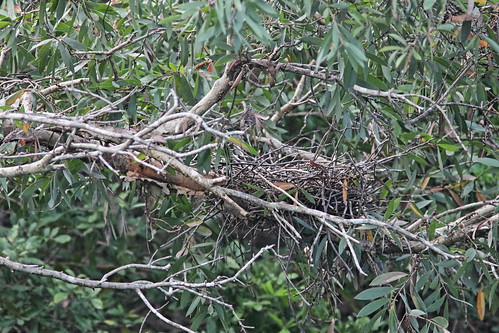
The next day, an adult Yellow-crowned Night-Heron was sitting low on the nest:

I subsequently photographed eggs in the nest, but had to fly back out to Illinois to close the sale of our condo. A few weeks later I returned to Florida and found only a single immature heron in the rookery. Here it was in early July, 2018:
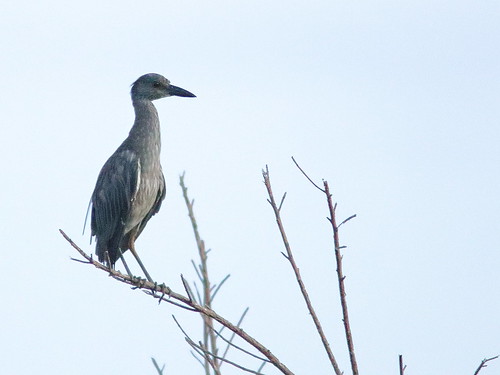
In August, 2018 it had begun to molt into adult plumage:

I cannot say for sure that it is the same bird, but this is a sub-adult roosting very close to the nest site in the condemned tree, marked for removal (October 18, 2018):
 After the cutting, only one pair out of the several night-herons which had gathered in the damaged area stayed on and built a nest, as documented in my earlier post. A single immature bird remained to roost next to the stump of the only tree which held a nest in the previous spring. Was it the same bird? Did it hatch from the nest in the missing tree? Here it is in December, 2018. Note that its head is streaked, a feature which may persist into its second year of life:
After the cutting, only one pair out of the several night-herons which had gathered in the damaged area stayed on and built a nest, as documented in my earlier post. A single immature bird remained to roost next to the stump of the only tree which held a nest in the previous spring. Was it the same bird? Did it hatch from the nest in the missing tree? Here it is in December, 2018. Note that its head is streaked, a feature which may persist into its second year of life:

For weeks, it was the only immature bird in the rookery, seen here on February 12, 2019:

As spring approaches, adults in breeding condition develop head and back (occipital and scapular) plumes. Their heads turn clear yellow and their legs become red:


This takes us up to the present. Inexplicably, on March 9, 2019, the pair which was building the nest (as documented in my earlier post) simply disappeared. Suddenly the rookery was abandoned-- almost. The sub-adult was reliably present every day, roosting next to the site formerly occupied by the nest tree. Then it also disappeared for a few days and I concluded that the rookery had indeed been abandoned.
However, on April 16, the (same?) sub-adult reappeared. This time it was accompanied by an adult in bright breeding plumage which performed a courtship display!
Note the absence of head plumes on the female:

The male has full plumes and red legs:
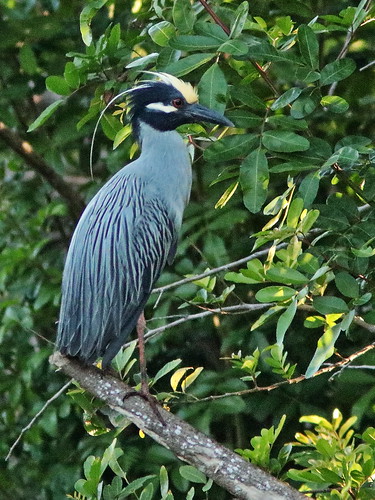
He displayed to the somber female, and also started carrying in nesting material to an area of the rookery which was left undamaged:

As a bonus, a bonded pair of Green Herons appeared. Although I failed to obtain a photo of the action, a third one showed up and was chased away. Luckily, it landed in a small tree right next to me. This is the interloper. Note yellow legs as opposed to the members of the pair, which were in breeding plumage and had red legs. The emerging leaves of the Mahogany tree enhanced this portrait:
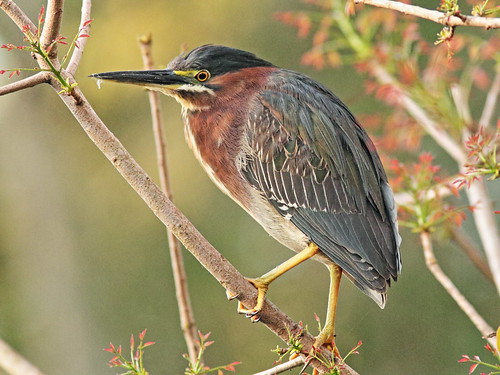
Since I plan to be away for week after Easter, I have prepared this in advance. A few other images from the past few days--
Horned Bladderwort emerged in the lakeside marsh. This is a carnivorous plant which traps small insects and other tiny organisms, digesting them in its "bladders," underwater tubes which snap open and suck in the prey. This allows it to survive where the environment is poor in nutrition. Its foliage and seeds are poisonous:

Interestingly, another species of bladderwort, Little Floating Bladderwort, occupied the same patch of shallow open water:

The sky was pink before sunrise in the ATV-scarred north Wet Prairie:

A Solitary Sandpiper cast a nice reflection as it foraged in the tracks left by the "wreckreational vehicles:"
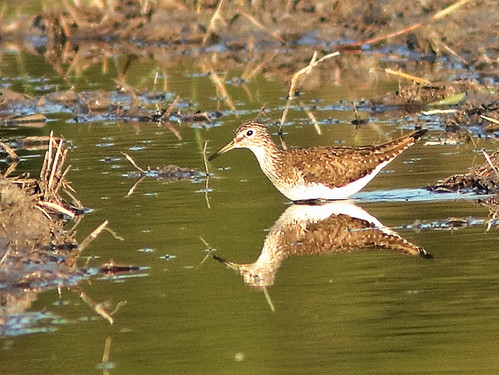
At a high spot in the wetlands, the pumpkin-like fruit of a wild exotic Surinam Cherry brightened the scene:
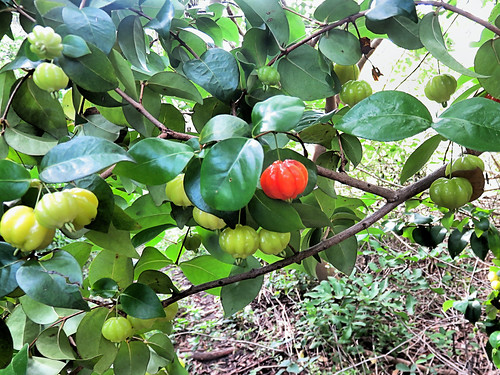
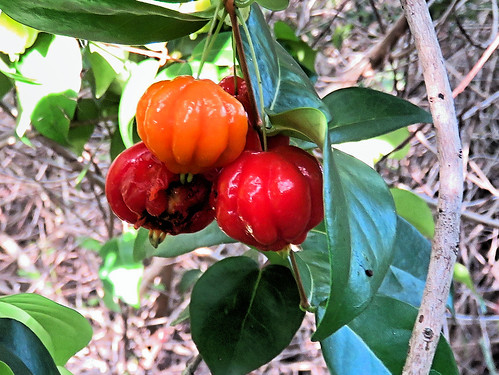
= = = = = = = = = = = = = = =
Linking to Misty's CAMERA CRITTERS,
Linking to Eileen's SATURDAY'S CRITTERS,
Linking to SKYWATCH FRIDAY by Yogi, Sylvia and Sandy
Linking to WEEKEND REFLECTIONS by James
Linking to BirdD'Pot by Anni
Linking to Our World Tuesday by Lady Fi
Linking to Wild Bird Wednesday by Stewart
Linking to Wordless Wednesday (on Tuesday) by NC Sue
Linking to ALL SEASONS by Jesh
________________________________________________
Please visit the links to all these memes to see some excellent photos on display
________________________________________________
Birds' faces are frozen in place. They cannot smile, frown or otherwise change their expressions. Yet a certain tilt of a vireo's head can cause us humans to imagine that they can.
This White-eyed Vireo emerged from a thicket for only a few seconds as I feverishly snapped a burst of photos.



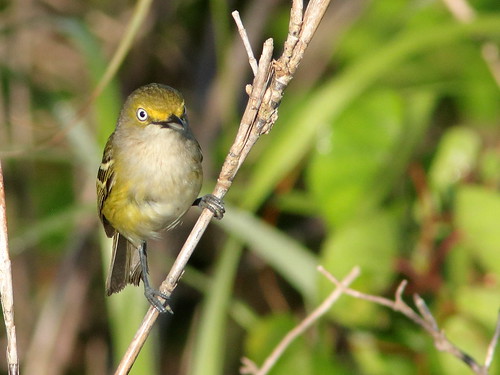



Back at home, we have a new addition (besides our latest great-granddaughter!). A boater damaged the Mallard decoy which serves as a float for our lawn irrigation system, so it was replaced by a goose. No sooner had it been put into service when a Double-crested Cormorant with emerald jewel eyes found it to be a convenient roost:


The Palm Warblers are migrating away to the north. This was the last one I saw, on March 28:

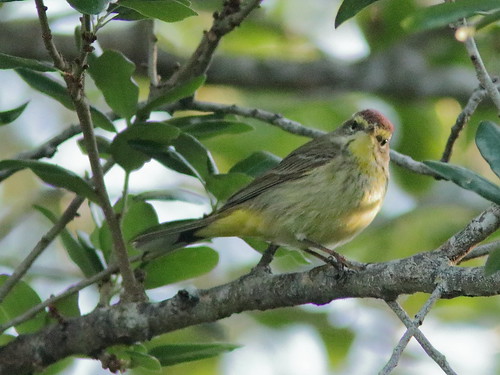
Great Crested Flycatchers are passing through...

...as are Northern Parula warblers:

A Raccoon paused on its way across the path:

A Black-and-White Warbler crept along the trunk of a small tree:
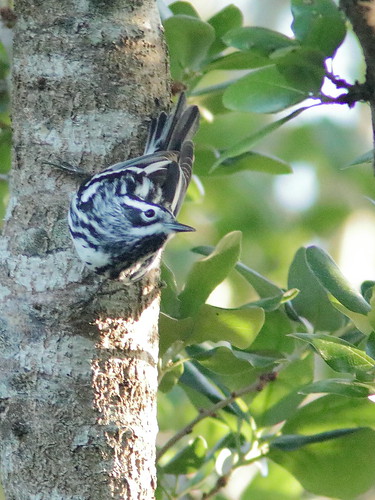

Mottled Ducks were courting. Two males chased three females:

Plumages of both sexes are similar. The two males have plain greenish yellow to orange bills, while the bills of the females are darker orange with black markings. The variable color of the wing speculum is due to reflection of sunlight):

Two pairs of Mottled Ducks lift off. Note the color of their bills. The males are often slightly larger than the females:

It was not a good day for reflections on the lake:

Before sunrise on March 31, an established feral Muscovy Duck looked out of place out in the wetlands:

The view to the west over still water, just before sunrise:
 = = = = = = = = = = = = = = =
= = = = = = = = = = = = = = =
Linking to Misty's CAMERA CRITTERS,
Linking to Eileen's SATURDAY'S CRITTERS,
Linking to SKYWATCH FRIDAY by Yogi, Sylvia and Sandy
Linking to WEEKEND REFLECTIONS by James
Linking to BirdD'Pot by Anni
Linking to Our World Tuesday by Lady Fi
Linking to Wild Bird Wednesday by Stewart
Linking to Wordless Wednesday (on Tuesday) by NC Sue
Linking to ALL SEASONS by Jesh
________________________________________________
Please visit the links to all these memes to see some excellent photos on display
________________________________________________
A little after sunrise, the wind was calm and the sky was entirely clear. The surface of the lake mirrored the unblemished blue from above. The morning silence was broken by the strident flight calls of two Black-necked Stilts as they settled near the water's edge.
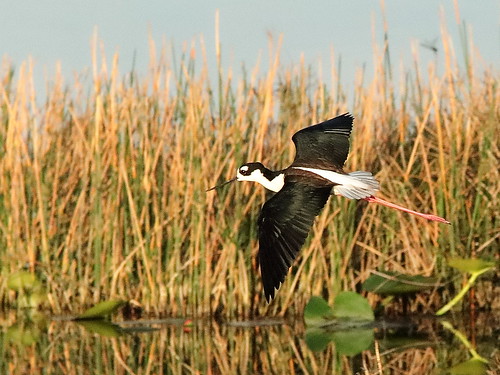
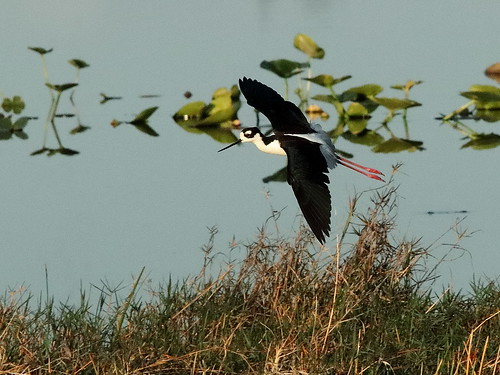

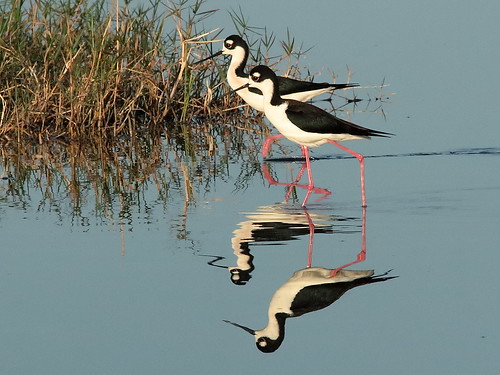
Two more arrived...
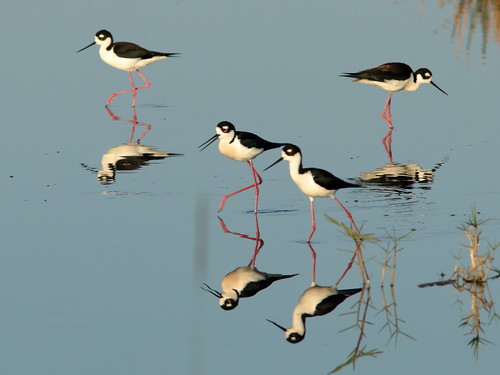
and three others joined them, seven in all:
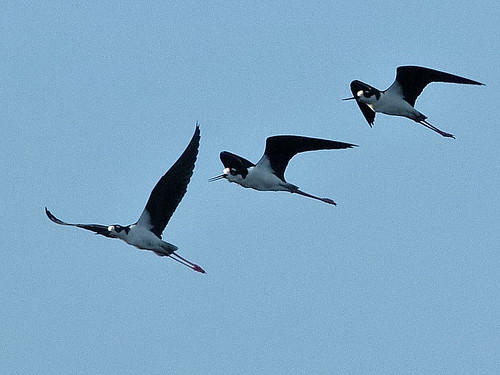
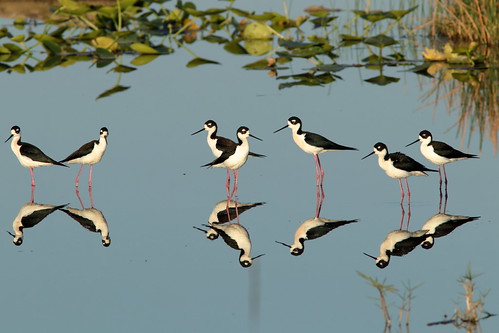

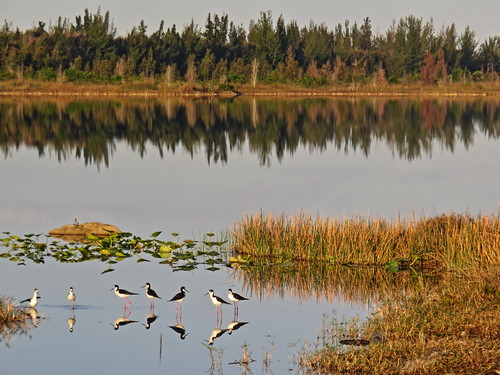
My camera's auto-focus was confused about whether to sharpen the real or the virtual image, and I too was a bit dazzled by the sight of fourteen black and white red-legged birds. Over the open water there was no sense of depth perception and my photos appeared to be two-dimensional:

It was like spelling banana-- I didn't know when to stop!
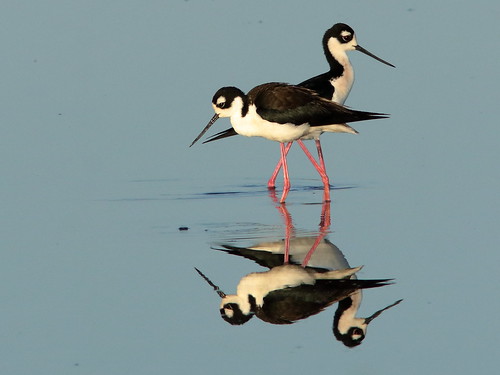
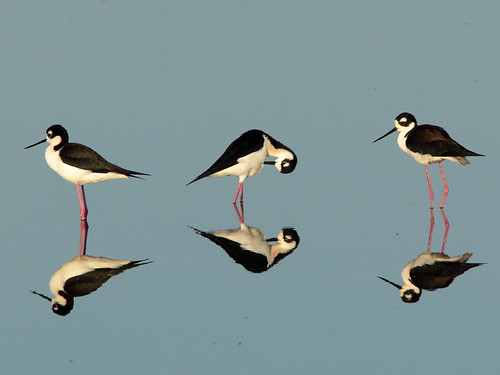
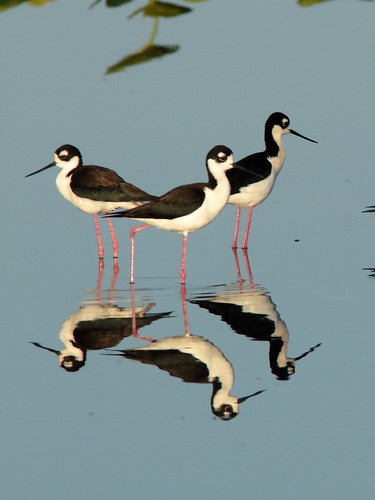


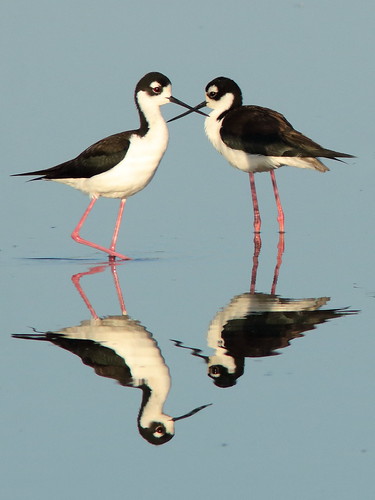
 Suddenly they flew off together and left me all alone, looking at an empty mirror:
Suddenly they flew off together and left me all alone, looking at an empty mirror:
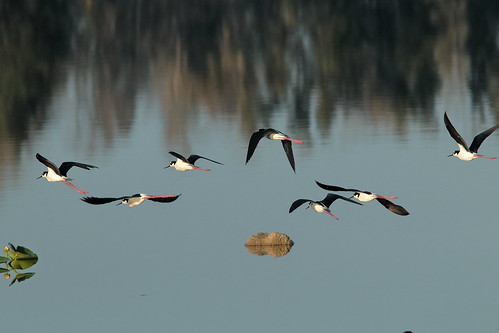
The next day (April 2), the Sun again rose against a cloudless sky. Venus shone above the crescent Moon:
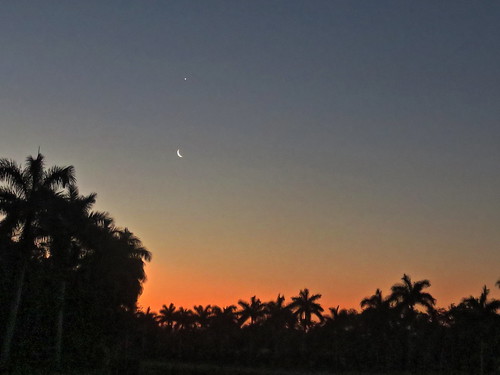
In the semi-darkness twenty minutes before sunrise, I had set my camera at maximum sensitivity and was rewarded when an Eastern Screech-Owl decided to call from a small tree next to the path. I did not use a flash and the image is a bit soft (hand-held with an exposure of 1/20 second at ISO 16,000). Click on the photo and look closely at its eyes to see a reflection of dawn's light on the horizon:
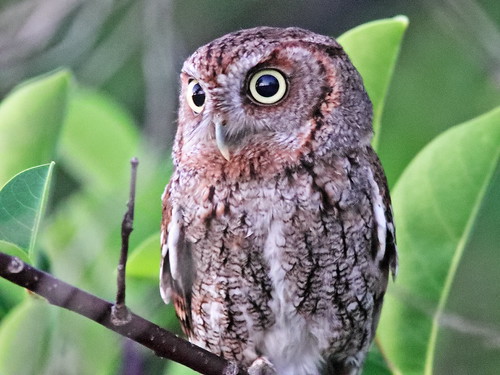
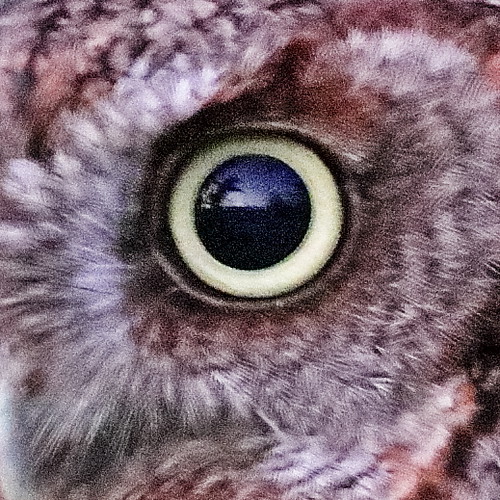 = = = = = = = = = = = = = = =
= = = = = = = = = = = = = = =
Linking to Misty's CAMERA CRITTERS,
Linking to Eileen's SATURDAY'S CRITTERS,
Linking to SKYWATCH FRIDAY by Yogi, Sylvia and Sandy
Linking to WEEKEND REFLECTIONS by James
Linking to BirdD'Pot by Anni
Linking to Our World Tuesday by Lady Fi
Linking to Wild Bird Wednesday by Stewart
Linking to Wordless Wednesday (on Tuesday) by NC Sue
Linking to ALL SEASONS by Jesh
________________________________________________
Please visit the links to all these memes to see some excellent photos on display
________________________________________________






























































